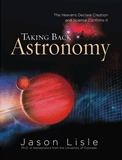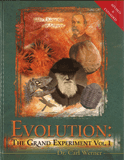News to Note, May 7, 2011
A weekly feature examining news from the biblical viewpoint
Persistent protein, corky canyon crust, computerized cooperation controversy, big bunnies, “explosive” evolution
This week:
- Persistent protein
- Dripping canyon crust
- Robotic evolution and kinship controversy
- The Bunny King
- “Explosive” evolution
- And Don’t Miss . . .
Did you miss it? Catch last week’s News to Note or any other!
1. Persistent Protein
Preservation of collagen fibers in a marine reptile fossil is said to prove “biomolecular preservation over deep time.”
2. Dripping Canyon Crust
The Grand Canyon slices through the high Colorado Plateau, but how did the plateau come to be so high? New seismic data paints a picture of the plateau’s underbelly.
3. NewScientist: “Cooperative Robots Obey Evolutionary Law”
Robots who “learned” how to share are “the first real confirmation of Hamilton’s rule, one of the most fundamental theories in modern biology.”
4. The Bunny King
Once upon a time a rabbit king was buried on Minorca . . .
A giant bunny that did not hop is showing up in children’s periodicals, prompting questions from our readers. The Nuralagus rex fossil, whose name means “rabbit king,” was recently found on the Mediterranean island of Minorca.
5. Physorg: “'Explosive' evolution in pupfish”
Pupfish in the Bahamas and the Yucatan, because they eat a different diet than other pupfish, are said to have evolved rapidly.
About 50 species of pupfish are found in the Americas. They all thrive in hot salty water. Most eat detritus and algae scraped off of rocks. But of the three species living on San Salvador Island, one eats snails and clam shrimp; another nibbles the scales off of other fish. In the Yucatan, one species eats fish and another, plankton.
Because the pupfish is believed by secular researchers to have spread across North America three to five million years ago and then to have been isolated by the formation of the lakes in the Bahamas and Mexico just eight to ten thousand years ago, these unusual species are said to have “evolved special jaws to match their diets” 130 times faster than other pupfish (LiveScience). Researchers are puzzled by the speed of the evolutionary change given that there seem to be no significant differences in the habitats or survival advantages of the aberrant dietary habits.
Evolution requires the development of new genetic information leading to the development of new kinds of creatures. But these are all pupfish. They are able to interbreed and therefore are different variations within the animal kind. Presumably these “special jaws” referred to are well-suited to the diet available to the fish, encouraging survival based on natural selection.
And Don’t Miss . . .
-
“Many millions of these mini-Big Bangs are already being produced daily” say researchers at the Large Hadron Collider, reporting they’ve increased the number of particles per beam by 6%. The idea is that the LHC will prove that the universe originated with the big bang. But it will not. The LHC is only simulating “the conditions that secular scientists believe existed during the big bang. Just because something can be done today doesn’t mean it has ever happened in nature in the past” (see Beams Collide Today in Expensive Hadron Collider).
-
The recently discovered Tiarajudens eccentricus, believed to be herbivorous because of its “spoon-shaped incisors,” also sports “long, pointy sabers.” Its molars were replaceable like those of many reptiles. It also had an occlusive bite: in other words, its top and bottom teeth fit together nicely. Stating that “dental occlusion evolved independently many times, which . . . means that nature was doing experiments with this,” Brazilian paleontologists expect the find to elucidate the evolution of “early tooth development.” The dog-sized therapsid is believed by evolutionists to be a 260-million year old “relative of today’s mammals.” But once again, we need to realize that common designs do not imply evolutionary ancestry but rather a common Designer who created fully functional creatures with the equipment they needed, including their teeth.
- Two species of Costa Rican beetles (genus Chrysina) produce brilliant metallic silver and gold coloring using layers of chitin which selectively reflect and amplify specific wavelengths of light. The 70 layers of chitin form a stack only 10 microns thick. Each layer refracts light differently to split the light like a prism. The reflected light combines with additional incoming light to produce a bright metallic appearance. This metallic look may help the creature to survive in its rainforest environment by allowing it to mimic the appearance of brightly reflective raindrops.
For More Information: Get Answers
Remember, if you see a news story that might merit some attention, let us know about it! (Note: if the story originates from the Associated Press, FOX News, MSNBC, the New York Times, or another major national media outlet, we will most likely have already heard about it.) And thanks to all of our readers who have submitted great news tips to us. If you didn’t catch all the latest News to Know, why not take a look to see what you’ve missed?
(Please note that links will take you directly to the source. Answers in Genesis is not responsible for content on the websites to which we refer. For more information, please see our Privacy Policy.)
Recommended Resources

Answers in Genesis is an apologetics ministry, dedicated to helping Christians defend their faith and proclaim the good news of Jesus Christ.
- Customer Service 800.778.3390
- © 2024 Answers in Genesis




